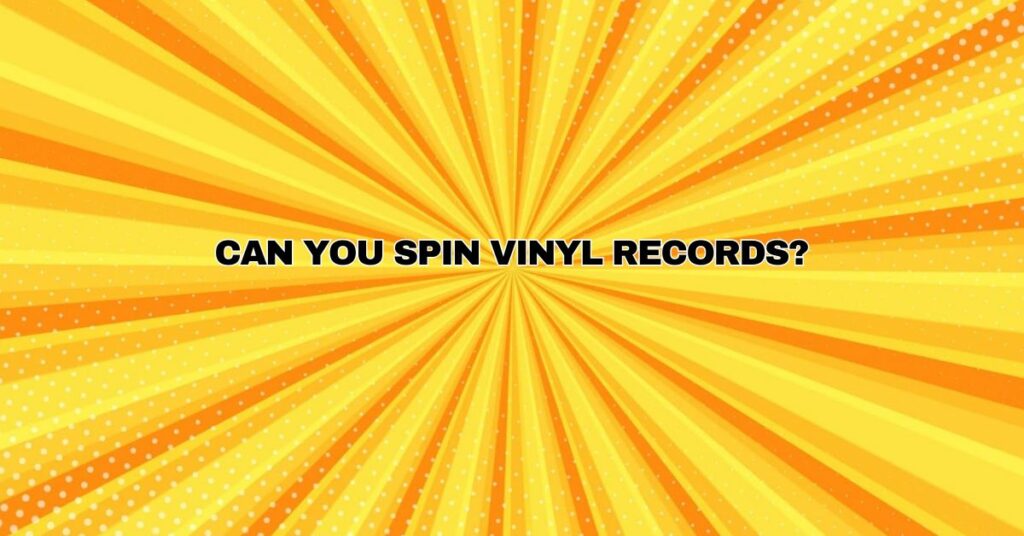Spinning vinyl records has a timeless allure that transcends generations. The act of placing a record on a turntable, carefully lowering the needle, and hearing the music come to life through analog grooves is a magical experience. In this article, we’ll explore the world of vinyl record spinning and answer the question: Can you spin vinyl records? Whether you’re a newcomer intrigued by the analog allure of vinyl or someone seeking to rekindle their passion for this classic medium, this guide will provide you with the knowledge and inspiration to start spinning records.
1. The Essentials of Vinyl Record Spinning
Before diving into the practice of spinning vinyl records, it’s essential to familiarize yourself with the fundamental components and equipment involved:
- Turntable: A turntable, also known as a record player, is the device used to play vinyl records. It typically consists of a plinth (base), platter (the rotating surface where the record sits), tonearm (the arm holding the cartridge and stylus), cartridge (housing the stylus or needle), and stylus (the needle that tracks the record’s grooves).
- Vinyl Records: Vinyl records come in various formats, including LPs (long-playing records) and 7-inch singles. They are etched with grooves that contain audio information, which is then translated into sound by the stylus.
- Amplifier and Speakers: An amplifier and speakers are necessary to amplify and project the audio signal from the turntable. Some turntables have built-in amplifiers and speakers, while others require external components.
2. Setting Up Your Turntable
Proper setup is crucial for a rewarding vinyl-spinning experience. Here’s a step-by-step guide to setting up your turntable:
- Placement: Position your turntable on a stable surface away from sources of vibration and direct sunlight. Ensure it’s level for optimal playback.
- Platter and Mat: Place the platter on the spindle, and if your turntable has a mat, position it on the platter. Some turntables have a slipmat for reduced friction.
- Balance the Tonearm: If your turntable has an adjustable tonearm, balance it using the counterweight to ensure the stylus applies the correct tracking force.
- Anti-Skate Adjustment: Set the anti-skate control to match the tracking force. This helps prevent the tonearm from dragging across the record.
- Connect to Amplifier: Use the appropriate cables to connect your turntable to an amplifier or receiver. Ensure the connections are secure.
- Ground Wire: Connect the turntable’s ground wire to the amplifier’s grounding post to reduce interference and hum.
3. Handling and Playing Vinyl Records
Now that your turntable is set up, let’s explore how to handle and play vinyl records:
- Handling Records: Always handle records by their edges to avoid smudging and leaving fingerprints on the grooves. Hold the record vertically when taking it out of its sleeve.
- Cleaning Records: Clean your records regularly using a carbon-fiber brush or anti-static brush to remove dust and debris. For deeper cleaning, consider using a record-cleaning machine or cleaning solution.
- Placing the Record: Carefully place the vinyl record on the platter, ensuring it’s centered.
- Lowering the Stylus: Gently lower the stylus onto the record’s surface, allowing it to make contact with the grooves. Avoid dropping the stylus abruptly.
4. Exploring the Vinyl Experience
Once your turntable is set up and you’re comfortable handling records, it’s time to immerse yourself in the vinyl experience:
- Album Artwork: Take the time to appreciate the album artwork and liner notes as you listen to the music.
- Side Flipping: Vinyl records typically have multiple sides, so be prepared to flip the record when one side ends.
- Engaging with Music: Engage with the music as it spins. Adjust the volume and soak in the analog warmth and texture that vinyl records offer.
- Collecting Vinyl: Many vinyl enthusiasts enjoy collecting records, hunting for rare releases, and building a diverse collection. Crate digging in record stores can be a fun and rewarding hobby.
5. Spinning Vinyl: A Personal Journey
Spinning vinyl records is a personal and immersive experience. It offers a unique connection to music and a tangible, physical interaction with the medium. The crackling sound of the stylus meeting the grooves, the visual allure of a spinning record, and the deliberate engagement with music are all part of the vinyl journey.
In conclusion, spinning vinyl records is a skill that can be learned and enjoyed by anyone with an interest in music. Whether you’re a newcomer or a seasoned enthusiast, vinyl offers a rich and authentic way to experience music. So, if you’re wondering whether you can spin vinyl records, the answer is a resounding yes. Embrace the world of vinyl and embark on a musical journey that’s as timeless as the medium itself. Happy spinning!


